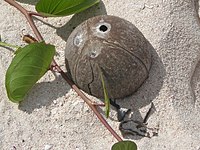

Sina and the Eel is a myth of origins in Samoan mythology, which explains the origins of the first coconut tree.[1]
In the Samoan language the legend is called Sina ma le Tuna. Tuna is the Samoan word for 'eel'.[2]
The story is also well known throughout Polynesia including Tonga, Fiji and Māori in New Zealand.[3]
Different versions of the legend are told in different countries in Oceania.[4] The coconut tree (Cocos nucifera) has many uses and is an important source of food. It is also used for making coconut oil, baskets, sennit rope used in traditional Samoan house building, weaving and for the building of small traditional houses or fale. The dried meat of the coconut or copra has been an important export product and a source of income throughout the Pacific.
The legend of Sina and the Eel is associated with other figures in Polynesian mythology such as Hina, Tinilau, Tagaloa and Nafanua.
Sina is also the name of various female figures in Polynesian mythology. The word sina also means 'white' or silver haired (grey haired in age) in the Samoan language. There is also an old Samoan song called Soufuna Sina based on a Sina legend.[5]


- ^ "Sina and the Eel". Living Heritage. Archived from the original on 2012-10-29.
- ^ Hunkin, Galumalemana; Paillat, Edith. "O le Tala ia Sina ma lana Tuna (Sina and the Eel)". www.wgtn.ac.nz. Retrieved 2021-01-09.
- ^ Craig, Robert D. (2004). Handbook of Polynesian Mythology. ABC-CLIO. p. 88. ISBN 978-1-57607-894-5.
- ^ Clark, Kate McCosh (2008). Maori Tales and Legends. Read Books. p. 68. ISBN 978-1-4437-5874-1.
- ^ Pratt, George (1862). A Samoan Dictionary English and Samoan, and Samoan and English; with a Short Grammar of the Samoan Dialect. London Missionary Society's Press. p. 23.